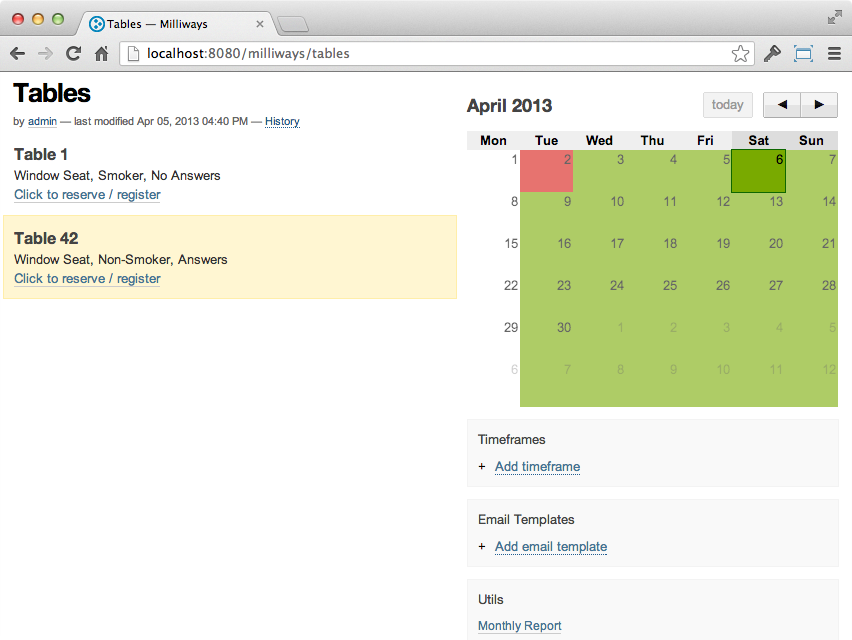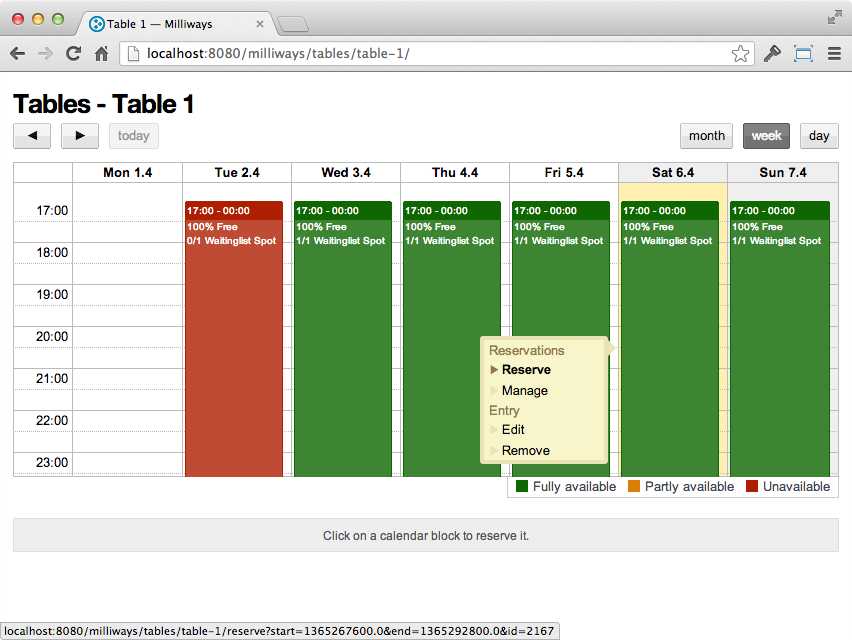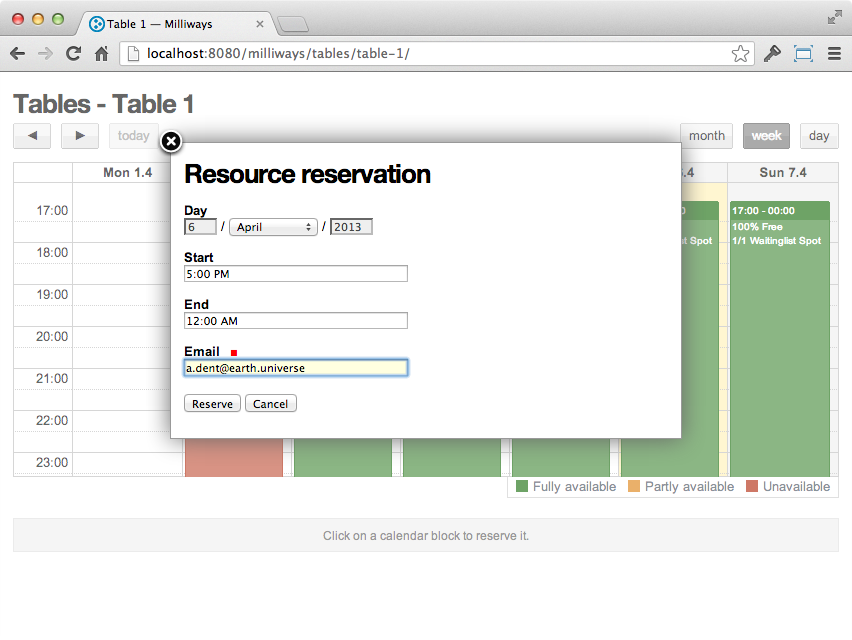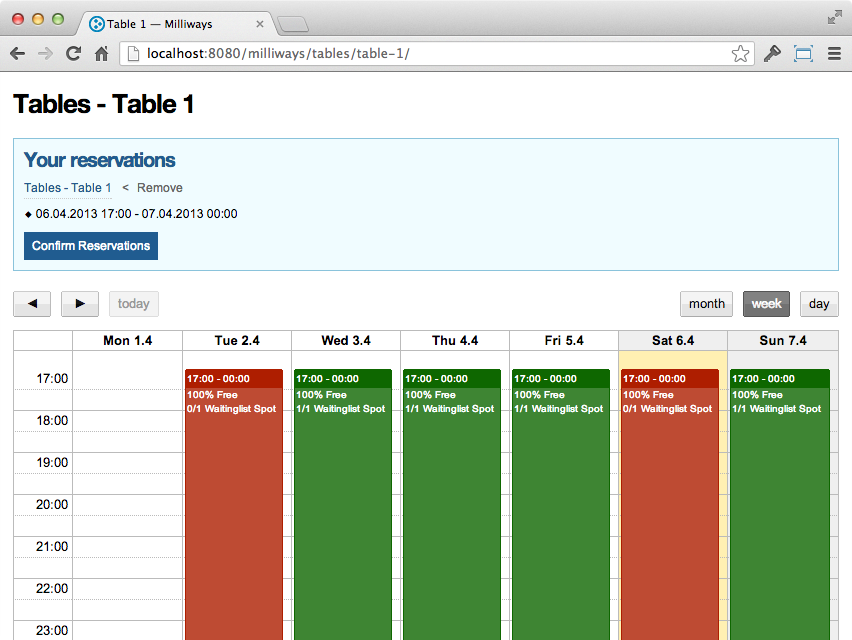Plone addon to reserve stuff in a calendar.
Project description
Not a replacement for Outlook or Google Calendar, but a system to manage reservations on the backend and to provide them on the frontend.
Introduction
Originally developed together with the municipality of Zug, Switzerland this Addon aims to combine differing reservation systems into one flexible solution.
It does so by providing a way to deal with the following usecases:
Manage meeting rooms in a company. Users reserve the rooms themselves without an authority confirming/denying their reservations.
Manage nursery spots. Parents apply for a spot in the nursery for their kid. Someone at the nursery goes through the applicants and decides who gets the spot. Parents may add an application to the waitinglist.
Manage community facilities. Citizens see the availability of facilities online and call the municipality to reserve a facility. The management is done internally (maybe through an already existing software). The addon is only used for display.
Screenshots



Build Status
Test Coverage
Latest PyPI Release
Requirements
Python 2.7
Plone 4.3+ ( Plone 4.1 and 4.2 had to be dropped, sorry )
Linux / Posix ( Windows may or may not work )
Postgresql 9.1+ ( Older versions DO NOT work! )
1024MB+ RAM
seantis.reservation is tested using IE8+, Chrome, Firefox. IE7 is not supported! Note also that IE8 and IE9 only work right if the Plone site is in production mode. The reason for it is that those browsers ignore every stylesheet after the 32th. In production these stylesheets are merged.
Note that we also rely heavily on javascript as the calendar shown for reservations is rendered through javascript. If your requirement is to run without javascript then this is not the droid you are looking for.
Limitations
These are the things seantis.reservation currently doesn’t do, or doesn’t do well:
Multilanguage. It is perfectly fine to run seantis.reservation in the language of your choice, though you might have to do some translations for yourself. However, you might find the ability to run the site in multiple languages (where the language is set on a per-request basis) to be lacking or with rough edges. It should mostly work but we cannot guarantee it or tell you that we tested this well.
Timezones. We currently do not store a timezone with the resource. Therefore comparing different resources of different timezones is a no go.
Recurrence. Though it is possible to create reservations with simple daily recurrence, it is not possible to modify them, so if you create 1000 recurrences and you make a mistake you have to delete all or adjust them each.
Installation
The setup instructions assume an Ubuntu / Debian Server installation as well as basic knowledge of Plone.
Install required packages
sudo apt-get install git-core sudo apt-get install libxml2 libxml2-dev sudo apt-get install libxslt1.1 libxslt1-dev sudo apt-get install python2.7 python2.7-dev
Install Postgresql
Run the installer
sudo apt-get install postgresql-9.1 sudo apt-get install postgresql-9.1-dev
If the dev package cannot be found try
sudo apt-get install postgresql-server-dev-all
Create a database user (replace your_password with your own). This password is needed later!
sudo -u postgres psql -c "CREATE USER reservation WITH PASSWORD 'your_password'"
Create the reservations database
sudo -u postgres psql -c "CREATE DATABASE reservations ENCODING 'UTF8' TEMPLATE template0"
Grant the required privileges to the reservation user
sudo -u postgres psql -c "GRANT ALL PRIVILEGES ON DATABASE reservations to reservation"
Install Plone
Download the buildout configs to the folder which will hold your Plone installation.
wget -qO - https://raw.github.com/seantis/seantis.reservation/master/buildout/buildouts.sh | bash
Or if you don’t have wget (like on OSX):
curl https://raw.github.com/seantis/seantis.reservation/master/buildout/buildouts.sh | bash
Edit your database connection settings in the database.cfg file.
nano database.cfg
Download the boostrap script
wget http://downloads.buildout.org/1/bootstrap.py
Again, alternatively with curl
curl http://downloads.buildout.org/1/bootstrap.py > bootstrap.py
Bootstrap your environment
python2.7 bootstrap.py
Run the installation (and get that coffee machine cracking)
bin/buildout
If everything went well you may now start your instance
bin/instance fg
Running Tests
The tests are run against a Postgres Database. This should be a database used for this purpose only. Therefore you should first create said database
sudo -u postgres psql -c "CREATE USER test WITH PASSWORD 'test'"
Create the test database
sudo -u postgres psql -c "CREATE DATABASE test ENCODING 'UTF8' TEMPLATE template0"
Grant the required privileges to the test user
sudo -u postgres psql -c "GRANT ALL PRIVILEGES ON DATABASE test to test"
To get the test script you should run the development buildout
bin/buildout -c develop.cfg
After that you need to tell the test script which database to use
cd src/seantis.reservation/seantis/reservation cp test_database.py.example test_database.py
You tell it by editing test_database.py and adding a testdsn like this
testdsn = "postgresql+psycopg2://test:test@localhost:5432/test"
You may then run the tests as follows
bin/test -s seantis.reservation
Creating a Reservation Plone Site
Create the Site
Having started your instance, navigate to the plone root:
http://localhost:8080
It should say ‘Plone is up and running’. On this site click “Create new Plone site” If you used the develop.cfg the username and password are “admin” and “admin”.
Obviously you do not want to use develop.cfg in production!
On the “Create a Plone site” form, you should enter name and title of your plone site, followed by checking the box of the following Add-On:
Seantis Reservation - for default plone theme
Having done that, click “Create Plone Site”
Create Resource Folder
On your freshly minted Plone Site, click on “Add new…” and choose “Folder”. Use any name you like.
Add a Resource
In the newly created folder, click on “Display” and choose “Resource Listing”.
This will turn the folder into a view designed for displaying Resources.
After changing the view click on “Add new…” and choose “Resource”. Enter any name you like.
You should now see a calendar in which you can create allocations that may be reserved. One level up, in the folder view, you may add more resources and compare them. Of course there is more to learn, but this is the basic setup of the Seantis Reservation module.
Data Structure
To really understand seantis.reservation it is important to understand a few core concepts:
Resource
Resources are Dxterity content types who display a calendar and interact with the core of seantis.reservation. They are heavy on the UI side of things, while being nothing more than a foreign key in the database.
Allocations
Everyone familiar with Outlook or Google Calendar knows that one can just click on an empty spot and add a new reservation.
In seantis.reservation this is not the case. In this module, a spot that may be reserved must be marked as such first. This is called an allocation.
The idea is to allocate time which may be reserved. It is like declaring time that should be managed by reservations. Outlook and Google Calendar implicitly see all time as allocated and under their management.
One reason for this is the fact that only through limiting the available time we can calculate meaningful utilization numbers. Another reason is that some periods of time may be overbooked, other times may not, or generally speaking: some timeperiods are different than others.
Allocations therefore define how periods of time may be reserved. They may not overlap for any given resource and they are independent of Plone and part of the SQL database model.
Reserved Slots
When reserving an allocation or a part of an allocation, reserved slots are generated. They ensure that no reservation is ever granted twice by accident.
Reserved slots may start every 5 minutes. At 5.35 or 5.40 for example, but not at 5.36 or 5.39. When reserving 45 minutes of an allocation, many reserved slots are spawned and aligned. Their primary keys then ensure on a low level basis that no overlaps occur.
For a much needed example:
Resource: 1234
Allocation: 09:00 - 10:00
=> reserve 1234, 09:30 - 10:00
Reserved Slots:
1234 09:30
1234 09:35
1234 09:40
1234 09:45
1234 09:50
1234 09:55
=> try to reserve 1234, 09:30 - 10:00 again
Reserved Slot 1234, 09:30 already exists
Of course there are a number of optimizations to ensure that we don’t generated millions of reserved slots. But this is basically it.
Reservations
Reservations exist in two states: Pending and Approved.
Pending reservations are reservations on a waitinglist. Users have submitted them, but nobody has confirmed them. They have therefore no reserved slot associated with them.
Approved reservations are reservations who are associated with reserved slots and are therefore confirmed and binding.
Note that it is possible in the UI side of seantis.reservation to go from pending to confirmed automatically. This is called auto-approval.
FAQ
Why is Database X not an option? / Why does Postgresql < 9.1 not work?
seantis.reservation relies on a Postgresql feature introduced in 9.1 called “Serialized Transactions”. Serialized transactions are transactions that, run on multiuser systems, are guaranteed to behave like they are run on a singleuser system.
In other words, serialized transactions make it much easier to ensure that the data stays sane even when multiple write transactions are run concurrently.
Other databases, like Oracle, also support this feature and it would be possible to support those databases as well. Patches welcome.
Note that MySQL has serialized transactions with InnoDB, but the documentation does not make any clear guarantees and there is a debate going on:
http://stackoverflow.com/questions/6269471/does-mysql-innodb-implement-true-serializable-isolation
Why did you choose SQL anyway? Why not use the ZODB? Why not insert your favorite NoSQL DB here?
If a reservation is granted to you, noone else must get the same grant. Primary keys and transactions are a natural fit to ensure that.
Our data model is heavily structured and needs to be validated against a schema.
All clients must have the same data at all time. Not just eventually.
Complicated queries must be easy to develop as reporting matters.
The core of seantis.reservation should eventually be independent of Zope/Plone.
Why / How is my allocation colored? My allocation is green, but it should be orange/red!
Basically colors are assigned to events based on their availability:
75-100% : Green / Available
1-74% : Orange / Partly Available
0% : Unavailable
The availability is calculated by taking the total time available and dividing it by the time reserved. If an allocation is set to be approved automatically (the default) a 0% availability also means that no new reservations can be made.
If an allcation is set to be approved manually, there’s automatically an unlimited waitinglist. Reservations to that waitinglist can be made at any time - unless the allocation setting is changed - and the number of people in the waitinglist is shown on the allcation itself.
Changelog
1.0.9
Fixes being unable to confirm ‘your-reservations’ outside the resource.
1.0.8
Adds a new view for exports which initially offers the existing reservations export and a new ‘compact’ export.
Adds created / modified columns to reservation exports.
Having different resources with different formsets no longer leads to errors when trying to do multiple reservations.
Increases the maximum allocation quota from 100 to 1000
Fixes typo in English text.
Improves German texts.
1.0.7
Removes potentially dangerous orphan removal from settings panel.
All reservation records stored in Postgres belonging to a certain resource are now wiped if said resource is deleted.
The exception is the removal of a plone site through the ZMI. Though it is possible to intercept that event it is not entirely save to discard all resources that are part of plone site being deleted. It is namely possible that those have the same uuid as another existing resource of another site.
To clean these kind of data zombies it might be good to create a tool with which reservations before a given date are wiped or archived.
This is however not a priority as it is recommended to have a separate database for each site anyway and until there’s a high volume reservations site in existance this won’t ever be a problem. Postgres can handle unused records.
Stops allocation.mirror_of from potentially being NULL.
Fixes a bug where reservations could be added to waitinglists on allocations that were not meant to have a waitinglist.
Fixes typo in German translation
1.0.6
Adds the ability to edit the formdata of a reservation through the management or the report interface
Adds the ability to define Manager Formsests which are the same as Default Formsets but can only be edited by someone with the appropriate permission.
With these formsets and the ability to edit the formdata it’s possible to create simple ways to organize reservations. A manager formset could be added with a checkbox “paid” for example, along a normal formset with the address.
Each reservation will then have an address filled by the user and a “paid”-checkbox. The reservee cannot see or change this checkbox, but the manager can do so once the reservee has actually paid whatever he was supposed to.
The initial values of those manager-only fields are defined throught the Dexterity-Schema editor.
No longer compresses URI.js, fixing javascript errors in the browser
Fixes missing translations in certain cases (locale.js is now more robust)
Uses ajax on the monthly report to load reservation changes
1.0.5
Adds whole-day flag to reservations export
Adds quota to reservations export
Adds the ability to show/hide the timetable in the monthly report
Keep filter state between months in monthly report
Adds basic support for plonetheme.teamraum
1.0.4
Fixes German translation typo
1.0.3
Adds email sent to managers when a new reservation was automatically approved
Focuses on first input when switching tabs in wizard forms
1.0.2
Fixes crash in JSON Encoder
1.0.1
Fixes some tiny issues
1.0
Initial release
Project details
Release history Release notifications | RSS feed
Download files
Download the file for your platform. If you're not sure which to choose, learn more about installing packages.
Source Distribution
File details
Details for the file seantis.reservation-1.0.9.tar.gz.
File metadata
- Download URL: seantis.reservation-1.0.9.tar.gz
- Upload date:
- Size: 185.6 kB
- Tags: Source
- Uploaded using Trusted Publishing? No
File hashes
| Algorithm | Hash digest | |
|---|---|---|
| SHA256 | 96627a0b59f46462ef2e39461aa589df1083b311c80524023bf5588256d2dcfc |
|
| MD5 | 642e2b424cfe74bb5768d3ca9d24a270 |
|
| BLAKE2b-256 | cf78cc1f56a3d8c2f4943cde1ebef04f91aba30709a88dd4f0307e34896a6f5c |















